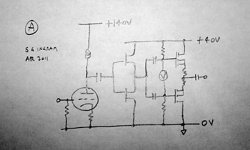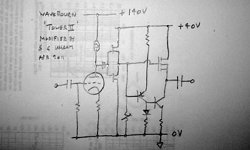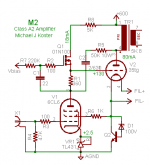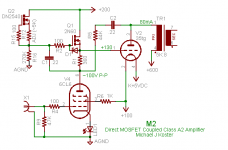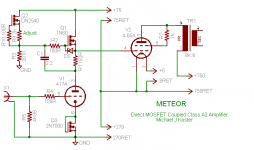Member
Joined 2009
Paid Member
I was very interested by the design Wavebourn showed us here:
http://www.diyaudio.com/forums/tubes-valves/147916-wavebourn-tower-iii-high-end-hybrid-amp.html
And of course this being DIY I thought about whether I might build this but with some constraints in mind it means some changes. Firstly, I have some trafo's without centre taps so I'd need an output capacitor and I would like to use just a single triode for the voltage amplifier stage.
and I would like to use just a single triode for the voltage amplifier stage.
A single triode doesn't have a very low output impedance so I am thinking of inserting a complimentary JFET follower between the triode and the output stage in place of the Pentode that is part of the original design.
I have assumed some understanding of the workings of the Wavebourn Tower II the output stage which might be somewhat naive ! I see a MOSFET source follower on top of a counter modulated current source. This current source is actually a current mirror, I've cheated and drawn the mirror as a diode + npn output transistor. The current is modulated by the pnp transistor that feeds it. Am I on the right track here ?
The attached diagram, Option C shows a very simplified sketch of the idea.
Option A shows my initial musings over a triode driving a Nelson Pass F4 (simplifier diagram) for comparison.
I'd be interested in your thoughts ?
Edit: I should have said 'Tower III' based on 'Tower II' sorry for the confusion !
http://www.diyaudio.com/forums/tubes-valves/147916-wavebourn-tower-iii-high-end-hybrid-amp.html
And of course this being DIY I thought about whether I might build this but with some constraints in mind it means some changes. Firstly, I have some trafo's without centre taps so I'd need an output capacitor
A single triode doesn't have a very low output impedance so I am thinking of inserting a complimentary JFET follower between the triode and the output stage in place of the Pentode that is part of the original design.
I have assumed some understanding of the workings of the Wavebourn Tower II the output stage which might be somewhat naive ! I see a MOSFET source follower on top of a counter modulated current source. This current source is actually a current mirror, I've cheated and drawn the mirror as a diode + npn output transistor. The current is modulated by the pnp transistor that feeds it. Am I on the right track here ?
The attached diagram, Option C shows a very simplified sketch of the idea.
Option A shows my initial musings over a triode driving a Nelson Pass F4 (simplifier diagram) for comparison.
I'd be interested in your thoughts ?
Edit: I should have said 'Tower III' based on 'Tower II' sorry for the confusion !
Attachments
I have assumed some understanding of the workings of the Wavebourn Tower II the output stage which might be somewhat naive ! I see a MOSFET source follower on top of a counter modulated current source. This current source is actually a current mirror, I've cheated and drawn the mirror as a diode + npn output transistor. The current is modulated by the pnp transistor that feeds it. Am I on the right track here ?
Yes, you got it right. Counter-modulated current source keeps as stable current through the source follower, as real load (speaker) permits.
It's a "2-store Tower", as I call it. A complete, "3-store Tower", has one more feature: the follower is augmented, so voltage between source and drain is kept as less variable as possible.
By the way, you may use a SRPP stage to drive it. Like, Michael Koster used to drive huge tubes on his avatar. I have not seen him here for a long time, and he does not answer on e-mail, so I am attaching his Meteor schematic here.
Attachments
Last edited:
Member
Joined 2009
Paid Member
Member
Joined 2009
Paid Member
It's the best in my mind too. However, I may build a 6 channel version and the push-pull way keeps the heat down a little 
I guess worse case I could drop into Class AB but I don't like this idea so much. This guy has something similar in his output structure and operated it in Class AB I believe: http://www.diyaudio.com/forums/solid-state/99313-ab-dynamic.html
End result will depend on how much heat I can allow. I have a lot of heatsink but it's relatively small fins and a tower shape amp won't fit in front of my home theatre screen. I think Class A for low power but moves to Class B for transients will be OK - and perhaps your Swinik A + C is better for that ???
I guess worse case I could drop into Class AB but I don't like this idea so much. This guy has something similar in his output structure and operated it in Class AB I believe: http://www.diyaudio.com/forums/solid-state/99313-ab-dynamic.html
End result will depend on how much heat I can allow. I have a lot of heatsink but it's relatively small fins and a tower shape amp won't fit in front of my home theatre screen. I think Class A for low power but moves to Class B for transients will be OK - and perhaps your Swinik A + C is better for that ???
and perhaps your Swinik A + C is better for that ???
Sure. It was made for energy efficiency. Similarly Walker's Quad was made. A+C is better approach for SS amps than AB that was good for tubes, that's why migrated to inappropriate technology.
Here is one more version: I am thinking of the same thing you are. I bought some 6S19P as driver tubes (6J9P+6S19P directly coupled), going to marry it with Audissey from Denon, and use this outputs:
An externally hosted image should be here but it was not working when we last tested it.
Member
Joined 2009
Paid Member
I remember this, Nuclon or something wasn't it ? It took me a year to understand what it was, that it was a pair of LTPs. Splendidly clever!
For my own weird reasons I have sworn myself off LTPs, never to use one again unless a re-build of an existing project. I developed a kind of permanent aversion to them, although really my objection is their use as error amplifiers in the front-end of gnf amps, but I think my allergic reaction might colour my feelings towards Nuclon because it's kind of in there too, with lots of local feedback.
I'm not against feedback mind you, but I've learned that it is only mans best friend when done very well indeed, very accurately and there are so many things waiting to trip you up when you use gnf that I wonder if I would know how to do it adequately. Phase shifts, reflections, injection of unwanted signals, parasitics and other wonderful things hiding in the dark.
So for my hybrid, no feedback except degeneration, keep it within my limited knowledge and deal with compensation of output stability with boring zobel / series inductor perhaps.
Swinik - with parallel BJT and MOSFET is it really just one kind of output, I think A + C you need MOSFET to stay 'off' until the BJT needs help, but I think you had an example using depletion mode MOSFET ???
Maybe I should stick with simple Lateral MOSFET output. I am also going to check out availability of high power JFETs.
You are using two tubes, I want a design that I can use with only one tube. One reason, not the only reason, is I want to consider use of Nuvistor for multichannel amplifier - I have some nice Russian parts spec'd to have high resistance to acceleration. I don't want to use two per channel.
For my own weird reasons I have sworn myself off LTPs, never to use one again unless a re-build of an existing project. I developed a kind of permanent aversion to them, although really my objection is their use as error amplifiers in the front-end of gnf amps, but I think my allergic reaction might colour my feelings towards Nuclon because it's kind of in there too, with lots of local feedback.
I'm not against feedback mind you, but I've learned that it is only mans best friend when done very well indeed, very accurately and there are so many things waiting to trip you up when you use gnf that I wonder if I would know how to do it adequately. Phase shifts, reflections, injection of unwanted signals, parasitics and other wonderful things hiding in the dark.
So for my hybrid, no feedback except degeneration, keep it within my limited knowledge and deal with compensation of output stability with boring zobel / series inductor perhaps.
Swinik - with parallel BJT and MOSFET is it really just one kind of output, I think A + C you need MOSFET to stay 'off' until the BJT needs help, but I think you had an example using depletion mode MOSFET ???
Maybe I should stick with simple Lateral MOSFET output. I am also going to check out availability of high power JFETs.
You are using two tubes, I want a design that I can use with only one tube. One reason, not the only reason, is I want to consider use of Nuvistor for multichannel amplifier - I have some nice Russian parts spec'd to have high resistance to acceleration. I don't want to use two per channel.
Last edited:
Member
Joined 2009
Paid Member
Member
Joined 2009
Paid Member
yes, it seems that way ! 
I'm still interested in the swinik 'perfect device' you posted some moons ago - BJT in parallel with MOSFET. If the deeper details are commercially sensitive just say so and I'll leave you alone
I don't have any FETs in my toolbox (nasty static sensitive things they are) so I'm wondering if it's worth the trouble of buying some to try this out. Is the end result "hi-fi" and do I want to be careful of any particular FET parameters in choosing a suitable FET ?
I'm still interested in the swinik 'perfect device' you posted some moons ago - BJT in parallel with MOSFET. If the deeper details are commercially sensitive just say so and I'll leave you alone
I don't have any FETs in my toolbox (nasty static sensitive things they are) so I'm wondering if it's worth the trouble of buying some to try this out. Is the end result "hi-fi" and do I want to be careful of any particular FET parameters in choosing a suitable FET ?
- Status
- This old topic is closed. If you want to reopen this topic, contact a moderator using the "Report Post" button.
- Home
- Amplifiers
- Tubes / Valves
- Modified Wavebourn Tower II ?
